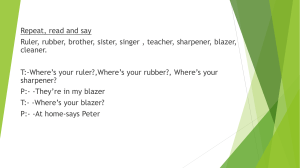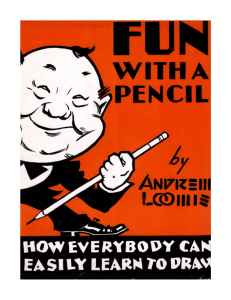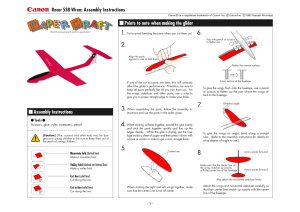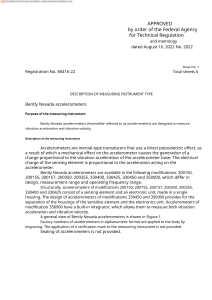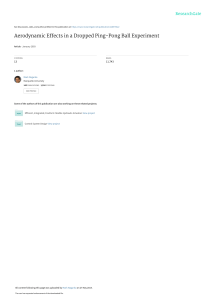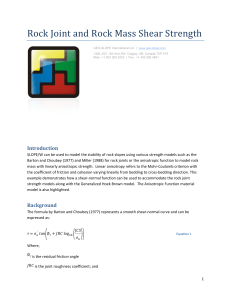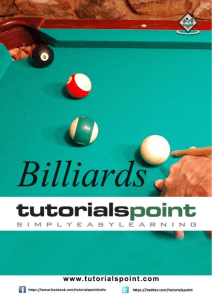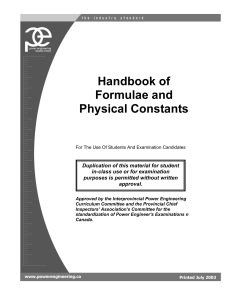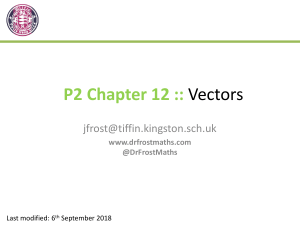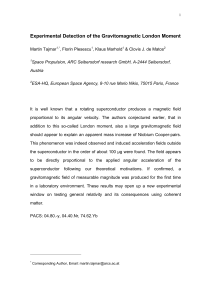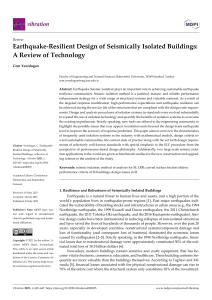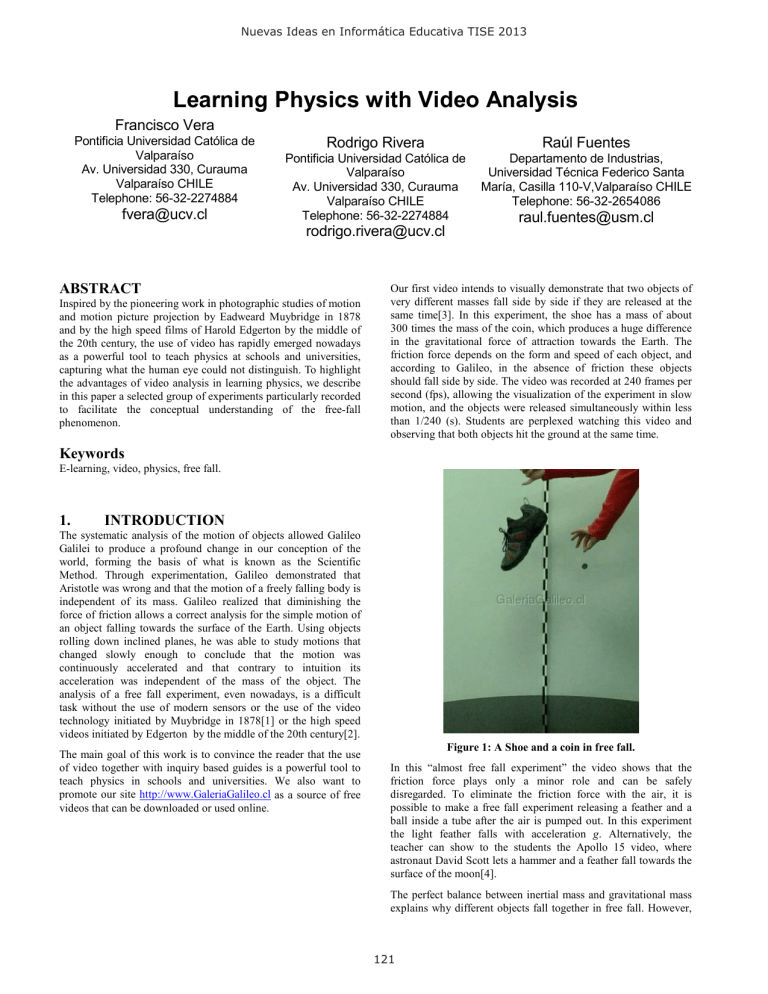
Nuevas Ideas en Informática Educativa TISE 2013 Learning Physics with Video Analysis Francisco Vera Pontificia Universidad Católica de Valparaíso Av. Universidad 330, Curauma Valparaíso CHILE Telephone: 56-32-2274884 [email protected] Rodrigo Rivera Rodrigo Rivera Pontificia Universidad Católica de Valparaíso Av. Universidad 330, Curauma Valparaíso CHILE Telephone: 56-32-2274884 [email protected] ABSTRACT Inspired by the pioneering work in photographic studies of motion and motion picture projection by Eadweard Muybridge in 1878 and by the high speed films of Harold Edgerton by the middle of the 20th century, the use of video has rapidly emerged nowadays as a powerful tool to teach physics at schools and universities, capturing what the human eye could not distinguish. To highlight the advantages of video analysis in learning physics, we describe in this paper a selected group of experiments particularly recorded to facilitate the conceptual understanding of the free-fall phenomenon. Raúl Fuentes Raúl Fuentes Departamento de Industrias, Universidad Técnica Federico Santa María, Casilla 110-V,Valparaíso CHILE Telephone: 56-32-2654086 [email protected] Our first video intends to visually demonstrate that two objects of very different masses fall side by side if they are released at the same time[3]. In this experiment, the shoe has a mass of about 300 times the mass of the coin, which produces a huge difference in the gravitational force of attraction towards the Earth. The friction force depends on the form and speed of each object, and according to Galileo, in the absence of friction these objects should fall side by side. The video was recorded at 240 frames per second (fps), allowing the visualization of the experiment in slow motion, and the objects were released simultaneously within less than 1/240 (s). Students are perplexed watching this video and observing that both objects hit the ground at the same time. Keywords E-learning, video, physics, free fall. 1. INTRODUCTION The systematic analysis of the motion of objects allowed Galileo Galilei to produce a profound change in our conception of the world, forming the basis of what is known as the Scientific Method. Through experimentation, Galileo demonstrated that Aristotle was wrong and that the motion of a freely falling body is independent of its mass. Galileo realized that diminishing the force of friction allows a correct analysis for the simple motion of an object falling towards the surface of the Earth. Using objects rolling down inclined planes, he was able to study motions that changed slowly enough to conclude that the motion was continuously accelerated and that contrary to intuition its acceleration was independent of the mass of the object. The analysis of a free fall experiment, even nowadays, is a difficult task without the use of modern sensors or the use of the video technology initiated by Muybridge in 1878[1] or the high speed videos initiated by Edgerton by the middle of the 20th century[2]. The main goal of this work is to convince the reader that the use of video together with inquiry based guides is a powerful tool to teach physics in schools and universities. We also want to promote our site http://www.GaleriaGalileo.cl as a source of free videos that can be downloaded or used online. Figure 1: A Shoe and a coin in free fall. In this “almost free fall experiment” the video shows that the friction force plays only a minor role and can be safely disregarded. To eliminate the friction force with the air, it is possible to make a free fall experiment releasing a feather and a ball inside a tube after the air is pumped out. In this experiment the light feather falls with acceleration g. Alternatively, the teacher can show to the students the Apollo 15 video, where astronaut David Scott lets a hammer and a feather fall towards the surface of the moon[4]. The perfect balance between inertial mass and gravitational mass explains why different objects fall together in free fall. However, 121 Nuevas Ideas en Informática Educativa TISE 2013 some students who do not understand the role of these concepts in Newton's second law tend to think that any object, such as very light objects or a pivoted bar, will fall with an acceleration equal to g. Below we will show that using video it is possible to demonstrate that not any object falling in the presence of gravity falls with acceleration g, and that for the acceleration to be g it is necessary that the body is affected only by the force of gravity and not by other forces. To show how video analysis can be also a useful tool in research, we will also discuss a simple experiment that is commonly demonstrated in a first course of Newtonian Mechanics, where the video allowed us to demonstrate that the typical accepted explanation given by teachers was wrong. 2. FRICTION AND FREE FALL The role of friction in the motion of a falling body can be introduced by noting that a parachute affects the motion in such a way that the object reaches a safe terminal constant speed instead of increasing its velocity at a constant rate of g = 9,8 m/s2. In the typical laboratory experiment used to show the effects of friction, several spheres of different radii are released in a viscous fluid to measure their constant terminal velocities. In the modern simpler version of this experiment several stacked cupcake paper cups are released simultaneously and a video of the motion is used to obtain their position and time coordinates[5]. Figure 2 shows the setup used to simultaneously drop a ball and several sets of stacked paper cups. Figure 2: Setup to drop stacked paper cups simultaneously. Figure 3 shows a y vs t plot for 1, 2, 4 and 8 stacked paper cups dropped simultaneously with a small ball. Because the effect of friction on the motion is small at low speeds, all plots coincide just after the objects are released. The plot for the ball is well fitted by a parabolic curve but the paper cups plots depart from this trend as a consequence of the changing friction force with the air. These plots end as straight lines whose slopes correspond to the terminal speed of each set of stacked paper cups. Figure 3: y vs t plot for stacked paper cups dropped simultaneously with a small ball. 3. A 100 YEARS OLD MISTAKE We designed a simple experiment that clearly demonstrates a common error in the explanation of the classic experiment where a small piece of paper is put over a book (or a coin) and the system is then let to fall[6,7]. This classic demonstration is used in introductory physics courses to show that because the book eliminates the friction force on the piece of paper by the air, the paper falls with acceleration g. To test whether the paper falls behind the book with a negligible friction force in a nearly free fall motion or if it is “dragged” by the book, we designed a variation of this experiment in which a ball and a piece of paper are put over a book that is forced to fall using elastic cords. We recorded a video of our experiment using a high-speed video camera at 300 fps. This video shows that the book and the paper fall faster than the ball, which falls behind the book with acceleration approximately equal to g. Our experiment shows that the piece of paper is then dragged behind the book and therefore the paper and book demonstration should not be used to show that in the absence of friction all objects fall with acceleration g independently of their mass. Figure 4: The paper and book experiment. Figure 4 shows the final stage of this experiment. This image belongs to a sequence of images obtained from the video of this experiment[8], that are visualized in a web page that allows the user to click on the objects to obtain position and time 122 Nuevas Ideas en Informática Educativa TISE 2013 coordinates[9]. The frame shown in this figure was selected because it shows the piece of paper behind the book, while the free falling ball (that was released just above the piece of paper) appears now far from it. The slow motion video shows that the book falls faster than free fall, dragging the piece of paper also in a faster than free fall motion. This experiment allowed us to conclude that in the typical paper and book demonstration the paper falls in a nearly free fall motion because the book falls in a nearly free fall motion and drags the piece of paper. The paper and book demonstration has been used incorrectly for more than 100 years to demonstrate in a simple form the role of friction in a free fall experiment. We repeated our modified version of this experiment using a metal plate instead of the book and a feather instead of the piece of paper and the metal plate was forced by a spring[10]. This experiment was recorded at 300 fps changing the camera position in order to obtain a better viewpoint that allowed to obtain coordinates for video analysis. Figure 6: The pivoted ruler experiment. The experiment shown in figure 6 was designed to show that the ball departs from the end of the ruler, arriving at the floor at a later time. For comparison, this figure also shows the ruler at the initial time. Because the ball is in free fall, the experiment clearly demonstrates that the free end of the ruler accelerates with acceleration bigger than g. The center of mass of the ruler is marked by the black circular region near the center of the ruler. After tracking the coordinates of the center of mass it is possible to conclude that the center of mass accelerates with acceleration different to g. This result is a direct consequence of the additional forces acting on the ruler's pivoting point near its lower end. 5. Figure 5: Plot for the feather and plate experiment. Figure 5 shows the height vs time plot for the ball and the feather. After fitting second order polynomials we obtained an acceleration of 9.6 m/s2 for the ball and a much larger acceleration of 34.9 m/s2 for the feather. This big acceleration for the feather can only be explained by a downwards force produced by pressure differences. The dragging force has a big effect either on the piece of paper or on the feather as a consequence of their small mass and large contact area, while it has little effect on the motion of the ball because of its bigger mass and its spherical shape. 4. OUR PIVOTED RULER The experiment shown in figure 7 was designed by us to directly visualize the acceleration of different parts of the ruler by comparing the motion of the ruler with the motion of several balls that are initially at rest on the ruler and that are free to move[12]. In this new experiment the ruler was released from a horizontal position with its left end pivoted. Applying Newton's second Law to study the motion of a horizontal pivoted ruler gives as a result that the point on the ruler at a position of 2/3 L falls initially with an acceleration equal to g. In our experiment the balls are initially above the horizontal ruler and they are free to move. Figure 7 clearly shows that the balls beyond 2/3 L separate from the ruler confirming that different point of the ruler have different accelerations and that a point near 2/3 L accelerates initially with g. A PIVOTED RULER We have seen that the experiment of dropping a shoe and a coin is a good approximation to a free fall motion and that experiments involving lighter objects clearly show the effects of the friction force. Now we will show a simple experiment[11] where a pivoted ruler is allowed to fall and as a consequence of the additional forces, the experiment departs from a simple free fall experiment. The pivoted ruler is released with a ball above its free end. In the video, an increase in the separation of the end of the ruler and the ball demonstrates that the free end moves with acceleration different to g. Figure 7: The horizontal pivoted ruler experiment. 123 Nuevas Ideas en Informática Educativa TISE 2013 6. A HAMMER IN 2D MOTION Any object moving only in the presence of the gravity force is considered to be moving in free fall. Different parts of the object can perform some apparently complicated paths but the center of mass of an extended object follows a simple parabolic motion. the Live Photo project members that also promote the use of video in teaching physics. 8. INQUIRY BASED LEARNING The videos from the Galileo's Gallery[14] project show simple experiments created as components of a sequence of experiments designed to teach physics at high schools and universities using inquiry based guides[15,16]. This new trend in physics education has gained many adepts because of its efficacy in producing large gains in physics concepts acquisition in students, while the old courses using only a white-board have proven not to produce good learning results. Inquiry based instruction is a mature field in physics education which can be easily complemented with a guided analysis and discussion of experiments, simulations, videos of experiments, or solving contextualized problems. In our case, we created guides that put the videos of experiments in a logic sequence and provide the opportunity for students to make predictions, discuss among them and with their teachers, and check their predictions against the experimental results, thus learning through “ doing science on a small scale”. Figure 8: A hammer in a parabolic motion. Figure 8 shows a hammer whose center of mass, marked by a white dot, follows a parabolic trajectory when thrown into a two dimensional motion[13]. After tracking coordinates, it is possible to obtain the y component of the center of mass acceleration ay = g. 7. E-LEARNING The teaching of physics can be greatly enhanced by the use of technology aided learning. In this context, the use of video can provide the basis for a modern alternative to learn physics in a contextualized form, where concepts are associated to simple but real experiments. There is no real substitute to learning physics through experimentation, and modern scientists systematically use the Scientific Method that allowed Galileo to initiate an explosive revolution in human knowledge. Galileo learned from experiments, and videos can provide an easy and low cost method to emulate and stimulate scientific thinking, thus guiding our students towards a deep understanding of physics concepts. We have used our videos from the Galileo's Gallery site[14] together with our inquiry based guides in computer labs in a one computer per student setup in first year physics courses. We have also used these videos in a normal classroom using inquiry based guides specifically designed to promote the discussion with students. Using a standard test designed to measure the conceptual learning of students (FCI) we obtained a conceptual gain below 13% for traditional courses in our university. This small learning is well documented in the international literature and it is also known that using inquiry based guides it can be increased to 50% or more. In the one computer per student setup we measured a gain of 53% and using video in a normal classroom we measured a gain of 30%. All the videos reported in this work are of our authorship and we use the Galileo's Gallery site to promote its use by middle school teachers and university teachers. We also maintain contact with 9. TRACKING COORDINATES Tracking coordinates from a video is a simple and powerful tool that allows to measure time and position for objects moving in one or two dimensions. Nowadays, it is possible to buy high speed video cameras that open the door towards a wide range of experiments that are very difficult to measure using other kind of sensors. Vernier Logger Pro[17] commercial software is one of the most used tools by physics teachers together with the open source software Tracker[18], Vernier also sells the Video Physics software for iPad and iPhone. The videos from the GaleriaGalileo.cl website[14] are free to use and easy to download and they can be directly used to obtain position and time coordinates by clicking on the images. After the manual tracking process is complete, the obtained data can be copied and pasted inside a spreadsheet for plotting and analysis. 10. CONCLUSIONS In this paper we have shown that the use of video can be a powerful tool to improve the students' learning of Physics. Our first experiment discussed in this work is a simple version of the Inclined Pisa Tower experiment, where objects of very different masses fall together if they are released at the same time. The other experiments show some important aspects to be included in a discussion of the importance of other forces in the study of falling bodies. Most of the experiments discussed above are simple modifications of known setups, but the experiments shown in figures 4 and 7 have been designed from scratch by the members of our research group to test some specific aspects of free fall. In particular, the experiment shown in figure 4 allowed us to evince that the 100 years old typical explanation given in the literature for the paper and book experiment was wrong. We created all the videos in the Galileo's Gallery site and we are actively promoting its use by other teachers to gather more data to prove the effectiveness of the use of video in improving students learning. 124 Nuevas Ideas en Informática Educativa TISE 2013 11. F. V. And R. R. would like to acknowledge financial support from FONDECYT Project 1110713 and from DGIP, Pontificia Universidad Católica de Valparaíso. R. F. acknowledges financial support from DGIP-Project 281232, Universidad Federico Santa María. 12. teacher. 47, 6(Sep. 2009), DOI=http://dx.doi.org/10.1119/1.3204119. ACKNOWLEDGMENTS REFERENCES [1] http://en.wikipedia.org/wiki/Eadweard_Muybridge [2] http://en.wikipedia.org/wiki/Harold_Eugene_Edgerton [3] Free fall http://laplace.ucv.cl/GaleriaGalileoDVD/Galeria/Mecanica/A CELERACIONcaida_libre_de_un_zapato_y_una_moneda/movimiento.html [4] Feather and hammer on the moon http://laplace.ucv.cl/GalileosGallery/FreeFall/featherhammer-moon/movimiento.html [5] http://laplace.ucv.cl/GalileosGallery/FreeFall/papercups/movimiento.html [6] ESA/ESTEC 2003 Air race between identical pieces of paper Physics on Stage 3 (Noordwijk, The Netherlands,8–15 November 2003) http://www.scienceonstage.ie/resources/POS3_booklet_Irela nd.pdf) p 5 [7] Vera, F, Rivera, R. (2011). A piece of paper falling faster than free fall. European Journal of Physics, 32, 5(Sep. 2011), 1245–1249. DOI=http://dx.doi.org10.1088/01430807/32/5/012. [8] Book and paper experiment http://laplace.ucv.cl/GalileosGallery/FreeFall/bookpaper/movimiento.html 370-373. [10] Book and feather experiment http://laplace.ucv.cl/GalileosGallery/FreeFall/bookfeather/movimiento.html [11] Pivoted beam whose end falls faster than g: http://laplace.ucv.cl/GaleriaGalileoDVD/Galeria/Mecanica/T ORQUE_Y_ROTACIONregla_cuyo_extremo_cae_con_aceleracion_mayor_a_g/movi miento.html [12] Several balls on a falling beam: http://laplace.ucv.cl/GaleriaGalileoDVD/Galeria/Mecanica/T ORQUE_Y_ROTACIONregla_con_pelotas_que_cae_con_aceleracion_mayor_a_g/mo vimiento.html [13] http://laplace.ucv.cl/GaleriaGalileoDVD/Galeria/Mecanica/T ORQUE_Y_ROTACIONmartillo_que_se_lanza_rotando_en_trayectoria_parabolica/m ovimiento.html [14] Galería de Galileo: http://www.GaleriaGalileo.cl [15] Hake, R.R. 1998. Interactive-engagement versus traditional methods: A six-thousand-student survey of mechanics test data for introductory Physics courses. Am. J. Physics 66, 1(Jan. 1998), 64-74. DOI=http://dx.doi.org/10.1119/1.18809 [16] McDermott, L.C. 1991. Millikan Lecture 1991: What we teach and what is learned – Closing the gap. Am. J. Phys. 59, 4(Apr. 1995), 301-315. DOI=http://dx.doi.org/10.1119/1.16538. [17] Vernier Logger Pro http://www.vernier.com/products/software/lp/ [18] Tacker http://www.cabrillo.edu/~dbrown/tracker/ [9] Vera F. and Romanque C. 2009. Another Way of Tracking Moving Objects Using Short Video Clips. The physics 125
